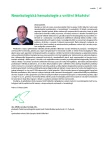Investigation of congenital thrombophilic conditions: when, in whom, focusing on what or not at all?
Authors:
Petr Dulíček
; Eva Ivanová; Zuzana Fiedlerová
Authors‘ workplace:
IV. interní hematologická klinika LF UK a FN Hradec Králové
Published in:
Vnitř Lék 2018; 64(5): 559-563
Category:
Overview
Venous thromboembolism is a multifactorial disease. Inherited thrombophilia is linked with increased risk of VTE and we know about them more than 50 years. Through a robust thrombophilia work-up in the end of millenium, the criteria for testing have significantly gone down. It is associated with increased amount of information about clinical consequence of testing. We discuss current recommendations not only in the literature, but also in our clinic.
Key words:
criteria for testing – thrombophilia – venous thromboembolism
Sources
- Nordsrtöm M, Lindblad B, Bergvist D et al. A prospective study of the incidence of deep vein thrombosis with a defined urban population. J Intern Med 1992; 232(2): 155–160.
- Egeberg O. Inherited antithrombin deficiency causing thrombophilia. Thromb Diath Haemorrh 1965; 13 : 516–530.
- Griffin JH, Evatt B, Zimmerman TS et al. Deficiency of protein C in congenital thrombotic disease. J Clin Invest 1981; 68(5): 1370–1373.
- Schwarz HP, Fisher M, Hapmeier P et al. Plasma protein S deficiency in familial thrombotic disease. Blood 1984; 64(6): 1297–1300.
- Comp PC, Nixon RR, Cooper MR et al. Familial protein S deficiency is associated with recurrent thrombosis. J Clin Invest 1984; 74(6): 2082. Dostupné z DOI: <http://dx.doi.org/10.1172/JCI111632>.
- Dahlbäck B, Carlsson M, Svensson PJ. Familial thrombophilia due to a previously unrecognized mechanism characterized by poor anticoagulant response to activated protein C; prediction of a cofactor to activated protein C. Proc Natl Scad Sci USA 1993; 90(3): 1004–1008.
- Bertina RM, Koeleman BPC, Koster T et al. Mutation in blood coagulation factor V associated with resistance to activated protein C. Nature 1994; 369(6475): 64–67. Dostupné z DOI: <http://dx.doi.org/10.1038/369064a0>.
- Poort SR, Rosendaal FR, Reitsma PH et al. A common genetic variation in the 3´-untraslated region of the prothrombin gene is associated with elevated plasma prothrombin levels and an in venous thrombosis and an increase in venous thrombosis. Blood 1996; 88(10): 3698–3703.
- Poul H, Kessler P. Trombofilní stavy: význam pro prevenci a léčbu žilního tromboembolizmu. Vnitř Lék 2009; 55(3): 242–252.
- Čingerová L, Kučeráková M. Thrombophilia. Vnitř Lék 2016; 62(12): 985–989.
- Chrobák L, Dulíček P. Thrombophilia states. Vnitř Lék 1998; 44(8): 481–486.
- Koster T, Rosendaal FR, de Ronde H et al. Venous thrombosis due to poor anticoagulant response to activated protein C: Leiden Thrombophilia Study. Lancet 1993; 342(8886–8887): 1503–1506.
- Martinelli I, Mannucci PM, De Stefano V et al. Different risks of thrombosis in four coagulation defects associated with inherited thrombophilia: a study of 150 families. Blood 1998; 92(7): 2353–2358.
- Simioni P, Sanson BJ, Prandoni P et al. Incidence of venous thromboembolism in families with inherited thrombophilia. Tromb Haemost 1999; 81(2): 198–202.
- Middeldorp S, Henkens CM, Koopman MM et al. The incidence of venous thromboembolism in family members of patients with factor V Leiden mutation and venous thrombosis. Ann Intern Med 1998; 128(1): 15–20.
- Christiaens L. Idiopathic venous thromboembolic disease. Risk factors for recurrence in 2006. Arch Mal Coeur Vaiss 2007; 100(2): 133–138.
- Linnemann B, Zgouras D, Schindewolf M et al. Impact of sex and traditional cardiovascular risk factors on the risk of recurrent venous thromboembolism: results from the German MAISTHRO Registry. Blood Coagul Fibrinolysis 2008; 19(2): 159–165. Dostupné z DOI: <http://dx.doi.org/10.1097/MBC.0b013e3282f54558>.
- Dalen JE. Should patients with venous thromboembolism be screened for thrombophilia? Am J Med 2008; 121(6): 458–463. Dostupné z DOI: <http://dx.doi.org/10.1016/j.amjmed.2007.10.042>.
- Dulíček P, Malý J, Pešavová L. Prevalence of inherited thrombophilia in young thrombosis patients from the East Bohemian region. Blood Coagul Fibrinolysis 2002; 13(6): 569–573.
- Den Heijer M, Lewington S, Clarke R. Homocysteine, MTHFR and risk of venous thrombosis: a meta-analysis of published epidemiological studies. J Thromb Haemost 2005; 3(2): 292–299. Dostupné z DOI: <http://dx.doi.org/10.1111/j.1538–7836.2005.01141.x>.
- Bezemer ID, Doggen CJ, Vos HL et al. No association between the common MTHFR 677C->T polymorphism and venous thrombosis: results from the MEGA study. Arch Intern Med 2007; 167(5): 497–501. Dostupné z DOI: <http://dx.doi.org/10.1001/archinte.167.5.497>.
- Croles FN, Nasserinejad K, Duvekot JJ et al. Pregnancy, thrombophilia, and the risk of a first venous thrombosis: systematic review and bayesian meta-analysis. BMJ 2017; 359: j4452. Dostupné z DOI: <http://dx.doi.org/10.1136/bmj.j4452.10.1136/bmj.j4452>.
- Wu O, Robertson L, Twaddle S et al. Screening for thrombophilia in high-risk situations: a meta-analysis and cost-effectiveness analysis. Br J Haematol 2005; 131(1): 80–90. Dostupné z DOI: <http://dx.doi.org/10.1111/j.1365–2141.2005.05715.x>.
- Baglin T, Gray E, Greaves M et al. Clinical guidelines for testing for heritable thrombophilia. Br J Haematol 2010; 149(2): 209–220. Dostupné z DOI: <http://dx.doi.org/10.1111/j.1365–2141.2009.08022.x>.
- Berse B, Lynch JA, Bowen S et al. In Reference to: “Cost and Utility of Thrombophilia Testing”. J Hosp Med 2017; 12(9): 783. Dostupné z DOI: <http://dx.doi.org/10.12788/jhm.2818>.
- Cox N, Johnson SA, Vasquez S. Patterns and Appropriateness of Thrombophilia Testing in an Academic Medical Center. J Hosp Med 2017; 12(9): 705–709. Dostupné z DOI: <http://dx.doi.org/10.12788/jhm.2804>.
- Colucci G, Tsakiris DA. Thrombophilia Screening: Universal, Selected, or Neither? Clin Appl Thromb Hemost 2017; 23(8): 893–899.Dostupné z DOI: <http://dx.doi.org/10.1177/1076029616683803>.
- Middeldorp S. Inherited thrombophilia: a double-edged sword. Hematology Am Soc Hematol Educ Program 2016; 2016(1): 1–9. Dostupné z DOI: <http://dx.doi.org/10.1182/asheducation-2016.1.1>.
- Linnemann B. Testing for thrombophilia in patients with venous thromboembolism – why and whom to test? Dtsch Med wochenschr 2016; 141(20): 1432–1435. Dostupné z DOI: <http://dx.doi.org/10.1055/s-0042–114094>.
- Pruthi RK. Optima utilization of thrombophilia testing. Int J Lab Hematol 2017; 39(Suppl 1): S104-S110. Dostupné z DOI: <http://dx.doi.org/10.1111/ijlh.12672>.
- Connors JM. Thrombophilia testing and Venous Thrombosis. N Engl J Med 2017; 377(12): 1177–1187. Dostupné z DOI: <http://dx.doi.org/10.1056/NEJMra1700365>.
Labels
Diabetology Endocrinology Internal medicineArticle was published in
Internal Medicine

2018 Issue 5
Most read in this issue
- Autoimmune hemolytic anemia
- Differential diagnosis of anemia
- Congenital and acquired bleeding disorders
- Hemoglobinopathies
